What if you could save time, money, and calories with one habit? That is the simple power of meal prepping ideas for weight loss. Meal prep means cooking and portioning food in advance, then storing it so healthy choices are ready during the week. It turns “What should I eat?” into “What did I already plan?”
The benefits pile up fast. Fewer decisions, better portions, steady calories, and less takeout. You get food that fits your goals and your schedule, even on busy days.
This guide is for beginners, students, parents, and anyone who wants easy, practical steps. You will get a quick plan, set-and-forget recipes, storage tips, and a 90-minute weekend flow. By the end, you will have a week of simple meals that taste good, keep you full, and help the scale trend down.
Why meal prep works for weight loss and how to set your plan
Weight loss comes from a steady calorie deficit. Meal prep helps you hit it without guesswork. When portions are set, calories stay predictable. That means less overeating and fewer “I will just order something” moments.
It also helps with satiety. Protein and fiber in prepped meals keep you full for hours. You avoid the snack spiral that happens when lunch was too small. Add high volume veggies and your plate looks big without spiking calories.
Decision fatigue is another hidden trap. By Wednesday, your brain is tired of choices. Prepped meals remove that pressure. You grab, heat, and eat. That consistency adds up to real progress.
You also save cash. Buying in bulk, cooking once, and using leftovers beats takeout. Your budget supports your goals instead of fighting them.
Keep it beginner friendly. Start small, learn as you go, and adjust portions based on hunger and energy. Your plan should fit your week, not the other way around.
Action steps to start today:
- Pick two meals and one snack to prep.
- Set calorie and protein ranges, not strict rules.
- Choose a prep style that fits your schedule.
- Shop from a simple list and buy budget staples.
- Block 90 minutes this weekend to cook and portion.
Find your calorie and protein targets without the math headache
Use light math to set easy ranges. For daily calories, try body weight in pounds times 10 to 12 for gentle loss. If you have a lot to lose or sit most of the day, start near 10. If you are active, start near 12.
Protein helps you stay full and hold muscle. Aim for 0.6 to 0.8 grams per pound of your goal weight. Split that across your meals.
Simple targets:
- Meals: 350 to 500 calories, 25 to 40 grams protein.
- Snacks: 150 to 200 calories.
- Visual portions: protein equals one palm, carbs equal one cupped hand, fats equal one thumb, veggies equal two fists.
These are starting points. If you feel hungry all day, add 100 calories to meals or bump protein. If energy dips, add carbs around workouts or active hours.
Pick a meal prep style that fits your week
You do not need one perfect method. Use what works this week.
- Batch cooking: one big pot or tray. Fast and cheap. Less variety, which is fine if flavor is strong.
- Portioned meals: ready boxes in the fridge. Great for grab and go. Takes a bit more time on prep day.
- Ingredient prep: cook base items, then mix later. More variety, slightly more daily assembly.
- Freezer kits: dump-and-cook packs for slow cooker or skillet. Good for busy weeks. You trade some fridge space for flexibility.
Mix styles based on your schedule. Start with two meals and one snack. Build from there.
Build a balanced plate that keeps you full
Use the simple plate method. Half non-starchy veggies, a quarter lean protein, a quarter smart carbs, plus a small healthy fat.
Protein ideas: chicken, turkey, tuna, tofu, eggs, Greek yogurt.
Carb ideas: brown rice, quinoa, beans, potatoes, whole wheat pasta.
Fat ideas: olive oil, avocado, nuts, seeds.
Veggies: leafy greens, broccoli, peppers, cauliflower, zucchini.
Shoot for 25 to 35 grams of fiber per day. Drink water with each meal, about 8 to 12 ounces, and sip across the day. Volume from veggies plus protein blunts cravings. Your meals feel bigger, so you snack less without trying.
Tools and containers that make prep easier
Basic gear speeds everything up:
- Sharp chef’s knife, big cutting board, sheet pans, large skillet, and a pot.
- Slow cooker or Instant Pot for set-it-and-forget-it meals.
- Blender for sauces and smoothies.
- Digital food scale and instant read thermometer for accuracy and safety.
Container tips:
- 28 to 32 ounce glass or BPA free plastic for meals.
- Two compartment boxes for keeping sauces or sides separate.
- One cup jars for oats and sauces.
- 12 to 16 ounce containers for snacks.
- Labels and painter’s tape for names and dates.
Spice starter set: garlic, onion powder, paprika, chili powder, cumin, Italian blend, curry, cinnamon.
7-day meal prepping ideas for weight loss you can start this week
Use a mix and match plan so boredom does not win. Pick three breakfast options, three lunch builds, and three dinners you can batch. Pack six snack choices to rotate. Most foods have easy swaps for vegetarian or gluten free needs.
Keep calories and protein in range, and let flavor do the heavy lifting. Favor batch friendly items like roasted trays, big pots of chili, and grains you can portion across meals. If you are new, aim for three prep days, for example, Sunday plus a quick Wednesday top-up.
Sample targets:
- Breakfasts under 400 calories, at least 20 grams of protein.
- Lunch bowls around 450 calories, 28 to 40 grams of protein.
- Dinners 420 to 480 calories, 30 to 40 grams of protein.
- Snacks 150 to 200 calories, paired with protein or fiber.
This simple flow keeps your week on track. It proves that meal prepping ideas for weight loss can be tasty, budget friendly, and repeatable.
Grab-and-go breakfasts under 400 calories
- High protein overnight oats: rolled oats, Greek yogurt, milk, chia, frozen berries. About 350 calories, 25 to 30 grams protein. Batch 4 jars, good for 4 days in the fridge.
- Veggie egg muffin cups: whisk eggs with diced peppers, spinach, and turkey or tofu. Bake in a muffin pan. Two muffins about 180 calories, pair with fruit to hit 300 to 350 calories. Store 4 days in the fridge or freeze up to 2 months.
- Cottage cheese parfait: cottage cheese, pineapple chunks, and a sprinkle of granola. About 350 calories, 28 grams protein. Prep 3 to 4 containers, add granola right before eating.
- Smoothie freezer packs: berries, banana slices, spinach, and protein powder in bags. Blend with milk or soy milk. About 300 to 350 calories. Freeze packs for 1 to 2 months.
Filling lunch bowls and salads around 450 calories
- Chicken quinoa bowl: grilled or roasted chicken, quinoa, roasted broccoli, tahini lemon sauce. About 450 calories, 35 grams protein. Keep sauce in a small container.
- Tuna and white bean salad: tuna, cannellini beans, arugula, olives, red onion, and a light vinaigrette. About 420 calories, 32 grams protein. Add lemon for brightness.
- Tofu stir fry: firm tofu, mixed veggies, brown rice, and low sodium soy sauce. About 460 calories, 28 grams protein. Add chili flakes if you like heat.
Layering tips to avoid soggy salads: dressing at the bottom, sturdy items next, greens on top. Keep crunchy toppings in a separate small bag or cup.
30-minute dinners you can batch cook
- Sheet pan chicken fajitas: chicken strips, peppers, onions, and fajita spice. Serve with tortillas or over rice. About 450 calories, 40 grams protein. Batch 4 to 6 servings. Reheat in a skillet or 350 F oven for 6 minutes.
- Turkey chili: ground turkey, beans, tomatoes, onions, spices. About 420 calories per 2 cups, 35 grams protein. Makes 6 to 8 servings. Freezes well for 2 to 3 months.
- Garlic soy salmon: salmon fillets, green beans, and small potatoes, tossed with soy, garlic, and a little oil. About 480 calories, 38 grams protein. Makes 4 servings. Reheat salmon gently to avoid drying.
Add volume sides: quick slaw with vinegar and salt, steamed veggies, or a side salad.
Light snacks that stop cravings
Six options, 150 to 200 calories each:
- Apple with 1 tablespoon peanut butter.
- Baby carrots with 2 tablespoons hummus.
- Greek yogurt cup with cinnamon.
- Cottage cheese and cucumber slices.
- Air popped popcorn, 3 cups.
- String cheese and grapes.
Pre-portion into small containers. Keep one snack in your bag or desk. Pair protein with fiber for steady energy.
Budget grocery list, storage, and food safety for meal prep
Shop smart so your plan does not break the bank. Buy staples that stretch across meals and freeze well. Use frozen produce when prices jump. Store food safely to keep taste and texture strong all week.
A simple list for one adult can cover breakfasts, lunches, dinners, and snacks. Build your cart around proteins, grains, beans, produce with long shelf life, and a few fat sources. Add flavor from pantry items like spices, vinegar, and citrus.
Cool and store food the right way. Spread hot rice or chili in shallow layers to cool faster. Label with names and dates so you eat the oldest first. Reheat to safe temperatures and keep sauces separate to protect texture.
With a few habits, your fridge looks like a plan, not a mystery box.
Smart shopping by food group with easy swaps
Base list:
- Proteins: chicken thighs, ground turkey, eggs, tuna, tofu, Greek yogurt.
- Carbs: brown rice, oats, whole wheat pasta, potatoes, canned beans.
- Produce: frozen mixed veggies, salad greens, onions, peppers, apples, bananas, carrots.
- Fats and extras: olive oil, peanut butter, hummus, salsa, low sugar sauces, spices.
Budget swaps:
- Frozen over fresh when prices spike.
- Dry beans instead of canned.
- Yogurt tubs instead of singles.
- Rotisserie chicken for quick builds.
Storage, freezing, and labeling made simple
Fridge life:
- Cooked proteins and grains: 3 to 4 days.
- Cooked veggies: 3 to 4 days.
- Dressed salads: 1 day.
- Undressed salads: 3 days.
Freezer:
- Most cooked meals last 2 to 3 months.
Label with name and date. Cool hot food within 2 hours. Spread rice on a tray to cool faster. Use airtight containers, keep sauces separate, and layer salads with dressing at the bottom, sturdy items next, greens on top.
Reheating tips that keep texture and taste
Microwave rice or pasta with a splash of water, cover loosely, and stir halfway. Use an air fryer or oven to crisp roasted veggies or chicken at 350 F for 5 to 8 minutes. Revive stir fry in a skillet with a little broth. Heat leftovers to 165 F. Add fresh elements after reheating, like herbs, lime, or yogurt sauce, to brighten flavors.
Prevent waste and save money
Use first in, first out order in the fridge. Freeze half of large batches on day one. Plan a catch all meal at week’s end, like fried rice, a sheet pan hash, or soup. Buy produce that lasts longer, such as cabbage, carrots, citrus, and frozen berries. Keep dressings and sauces in small jars to control portions and prevent soggy meals. Track what you did not eat and reduce next week’s batch size.
Make it stick: time-saving hacks, flavor upgrades, and staying on track
Consistency beats intensity. A repeatable routine will outwork a perfect plan you never follow. Keep prep short, flavors bold, and choices simple. Use quick pivots when life happens so the plan survives a busy day.
Set a 90-minute weekend routine. Add a few low calorie flavor boosters. Keep your freezer stocked with single servings. Check progress once or twice a week and adjust portions, not your entire plan.
When meals taste great and show up on time, the habit sticks.
A 90-minute weekend prep timeline
- Minute 0 to 10: preheat oven, start rice or quinoa, fill a pot for chili.
- Minute 10 to 30: season proteins, load sheet pans, chop veggies while food cooks.
- Minute 30 to 60: simmer chili, roast trays, blend a quick sauce, wash storage containers.
- Minute 60 to 80: assemble bowls and salads, portion snacks.
- Minute 80 to 90: label, cool, and store. Clean as you go to finish on time.
Flavor boosters that add taste without many calories
Go to boosts: citrus juice and zest, vinegars, fresh herbs, garlic, ginger, spice blends, hot sauce, salsa, mustard, low sodium soy sauce, miso, and tomato paste. Use dry rubs on proteins. Make yogurt based sauces with lemon and herbs. Quick pickled onions add crunch and tang. Watch portions of oils, nuts, and cheese.
Quick pivots when plans change
Keep backups on hand: canned tuna or beans, microwave rice cups, frozen veggies, whole wheat wraps, and eggs. Freeze extra portions in single servings. Mix and match components, swap chicken for tofu, rice for potatoes, or salsa for tahini. If you eat out, save the planned meal for the next day.
Track progress and stay motivated
Use simple checks. Weigh in once or twice a week. Take a weekly photo. Rate hunger before and after meals on a 1 to 10 scale. Plan one small win each week, like prepping only breakfasts, then add lunches. Find a meal prep buddy or set a calendar reminder. Celebrate consistency, not perfection.
Conclusion
Small steps, simple systems, and steady practice make meal prepping ideas for weight loss work in real life. Pick two breakfasts, two lunches, two dinners, and two snacks from the lists. Prep for three days to start, then build from there. Save or print the 90-minute timeline and grocery list so the plan runs on autopilot. Your meals can taste good, keep you full, and fit your week. Start this weekend and let routine, not willpower, drive results.
Related post: Healthy Food Ideas to Lose Weight
Smart Meal Prep FAQs for Weight Loss
How many calories should each meal have for weight loss?
Aim for a calorie deficit. Most people do well with 400 to 600 calories per meal, plus 100 to 200 calorie snacks. Adjust based on your size, activity, and hunger.
What should a balanced meal prep look like?
Build plates with protein, fiber, and healthy fats. Use half veggies, a palm-sized portion of protein, a cupped handful of carbs, and a thumb of fats.
Which proteins work best for meal prep?
Choose lean options that reheat well. Try chicken breast, turkey, tuna, salmon, shrimp, extra-firm tofu, tempeh, eggs, Greek yogurt, cottage cheese, or lentils.
What are simple low-calorie carbs to include?
Go for high-fiber carbs. Use quinoa, brown rice, farro, barley, oats, beans, lentils, sweet potatoes, berries, and corn tortillas.
How do I add volume without adding many calories?
Load up on vegetables. Roast broccoli, cauliflower, peppers, and zucchini. Add leafy greens, cabbage slaw, cucumbers, and tomatoes to bowls.
What are easy meal prep ideas for beginners?
Try these basics:
- Sheet pan chicken, broccoli, and sweet potatoes.
- Turkey chili with beans and peppers.
- Greek bowls with chicken, quinoa, cucumber, tomato, and tzatziki.
- Tofu stir-fry with mixed veggies and brown rice.
- Salmon, green beans, and roasted potatoes.
How can I keep meals from tasting bland?
Season with bold flavors. Use spice blends, citrus, garlic, ginger, fresh herbs, salsa, kimchi, pesto, or vinegar-based dressings. Add sauces after reheating to keep texture.
What are good low-calorie sauces and dressings?
Use yogurt-based sauces, salsa, tahini-lemon, chimichurri, mustard, hot sauce, and vinaigrettes. Keep portions small, about 1 to 2 tablespoons.
How many days can I store prepped meals?
Keep cooked meals in the fridge for 3 to 4 days. Freeze for longer storage, up to 2 to 3 months. Cool food within 2 hours, then refrigerate at 40°F or colder.
What containers should I use?
Use BPA-free, microwave-safe containers with tight lids. Choose shallow, portion-sized containers to cool faster. Glass works well for reheating and odor control.
How do I reheat safely?
Reheat to 165°F. Stir halfway for even heating. Add fresh toppings or sauces after reheating to keep crunch.
Can I freeze grain bowls or pasta?
Yes, with a few tweaks. Freeze grains and proteins. Add fresh greens, herbs, and dressings after thawing. Pasta can freeze if cooked slightly under al dente.
What are good breakfast meal prep ideas?
Try overnight oats, egg muffins, Greek yogurt parfaits, chia pudding, or breakfast burritos. Add fruit and a protein boost to stay full longer.
What snacks help with weight loss?
Pick protein and fiber. Try Greek yogurt, cottage cheese, fruit with nuts, hummus and veggies, jerky, edamame, or hard-boiled eggs.
How do I prevent overeating when meals taste great?
Pre-portion meals. Use smaller plates. Eat protein and veggies first. Keep trigger foods out of sight. Drink water before meals.
How do I meal prep on a budget?
Buy frozen veggies and bulk grains. Use beans, lentils, eggs, and canned tuna or salmon. Plan one-pot meals. Repeat ingredients across recipes to cut waste.
Can I do low-carb or gluten-free meal prep?
Yes. For low-carb, use cauliflower rice, zucchini noodles, leafy greens, and extra protein. For gluten-free, choose rice, quinoa, potatoes, corn tortillas, and certified gluten-free oats.
How much protein should I aim for per meal?
Most people do well with 25 to 40 grams per meal. Examples include 4 to 6 ounces of chicken, 1 cup Greek yogurt, or 1 cup lentils.
What if I am vegetarian or vegan?
Use tofu, tempeh, seitan, beans, lentils, edamame, and high-protein soy yogurt. Add nuts or seeds for healthy fats. Pair grains with legumes for a complete amino acid profile.
How do I build a weekly meal prep plan?
Pick 2 proteins, 2 carbs, and 4 veggies for mix-and-match bowls. Cook in batches on one day. Store in portions. Schedule one quick midweek top-up, like a fresh salad kit.
How do I handle cravings without blowing my plan?
Plan a treat that fits your calories. Keep fruit, dark chocolate, or a protein ice cream on hand. Add volume with berries or air-popped popcorn.
What if I get bored of the same meals?
Use one base, then switch flavors. Change sauces and spices, like Mexican, Mediterranean, or Asian-style. Rotate proteins and veggies each week.
Do I need to weigh and measure everything?
It helps at first. Use a food scale and measuring cups to learn portions. Over time you can eyeball with hand portions and plate ratios.
How do I track progress without obsessing over the scale?
Use weekly averages for weight. Track waist, photos, energy, sleep, and how clothes fit. Watch consistency with meals, not perfection.


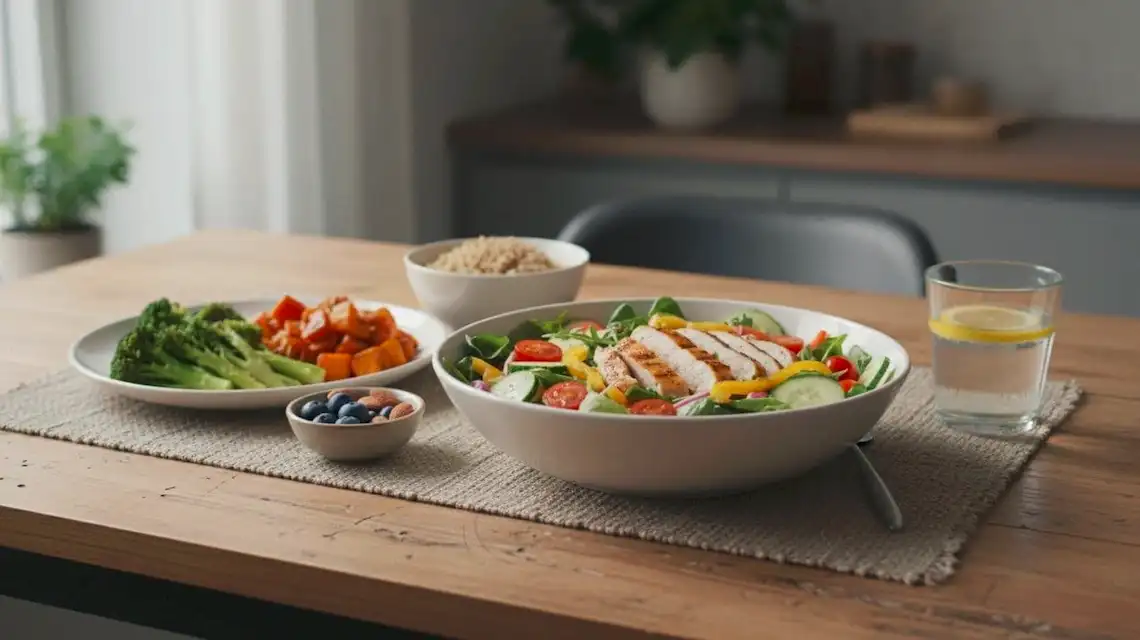

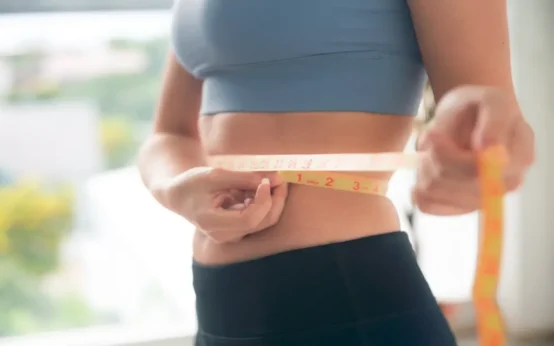 How to Start a Weight Loss Program
How to Start a Weight Loss Program 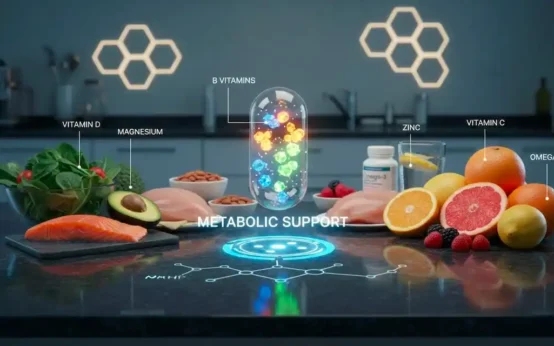 What Vitamin Deficiency Makes It Hard to Lose Weight?
What Vitamin Deficiency Makes It Hard to Lose Weight? 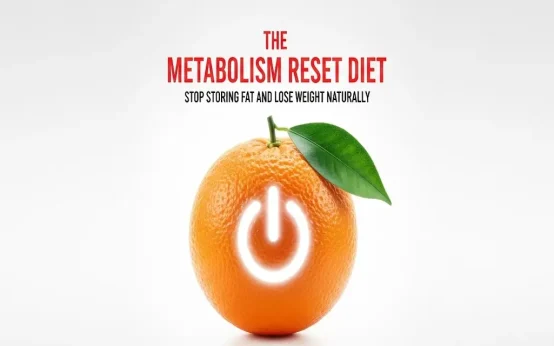 Improve Fat Burning With a Metabolism Reset Diet
Improve Fat Burning With a Metabolism Reset Diet  How to Avoid Loose Skin When Losing Weight
How to Avoid Loose Skin When Losing Weight  Good Eating Habits for Weight Loss
Good Eating Habits for Weight Loss 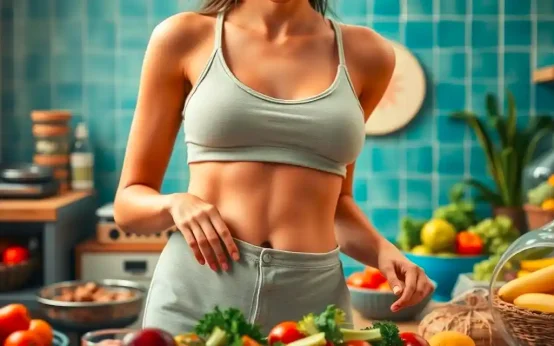 A Guide to Weight Loss for Busy People in Today’s Society
A Guide to Weight Loss for Busy People in Today’s Society